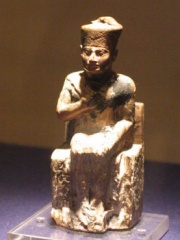
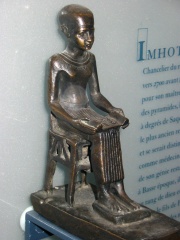
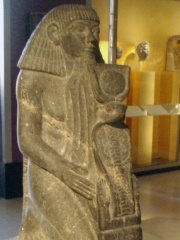
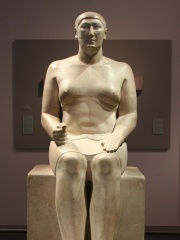
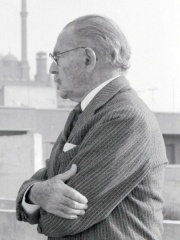
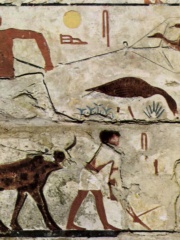
The Most Famous
ARCHITECTS from Egypt
This page contains a list of the greatest Egyptian Architects. The pantheon dataset contains 518 Architects, 7 of which were born in Egypt. This makes Egypt the birth place of the 20th most number of Architects behind Hungary, and Sweden.
Top 7
The following people are considered by Pantheon to be the most legendary Egyptian Architects of all time. This list of famous Egyptian Architects is sorted by HPI (Historical Popularity Index), a metric that aggregates information on a biography's online popularity.

1. Khufu (2700 BC - 2570 BC)
With an HPI of 86.57, Khufu is the most famous Egyptian Architect. His biography has been translated into 77 different languages on wikipedia.
Khufu or Cheops was the second pharaoh of the Fourth Dynasty of Egypt, reigning during the 26th century BC in the early Old Kingdom period. Khufu succeeded his father Sneferu as king. He is generally accepted as having commissioned the Great Pyramid of Giza, one of the Seven Wonders of the Ancient World, but many other aspects of his reign are poorly documented. Khufu is also the main character noted in the Westcar Papyrus from the 13th dynasty. The only completely preserved portrait of the king is a small ivory figurine found in a temple ruin of a later period at Abydos in 1903. All other reliefs and statues were found in fragments, and many buildings of Khufu are lost. Khufu's has a conflicting legacy: while the king enjoyed a long-lasting cultural heritage preservation during the period of the Old Kingdom and the New Kingdom, the ancient historians Manetho, Diodorus and Herodotus hand down a very negative depiction of Khufu's character. As a result, an obscure and critical picture of Khufu's personality persists.

2. Imhotep (2800 BC - 2700 BC)
With an HPI of 81.17, Imhotep is the 2nd most famous Egyptian Architect. His biography has been translated into 71 different languages.
Imhotep (; Ancient Egyptian: ỉỉ-m-ḥtp "(the one who) comes in peace"; fl. late 27th century BC) was an Egyptian chancellor to the King Djoser, possible architect of Djoser's step pyramid, and high priest of the sun god Ra at Heliopolis. Very little is known of Imhotep as a historical figure, but in the 3,000 years following his death, he was gradually glorified and deified. Traditions from long after Imhotep's death treated him as a great author of wisdom texts and especially as a physician. No extant text from his lifetime mentions these capacities, and none mention his name in the first 1,200 years following his death. The Westcar Papyrus of the Hyksos period, written in classical Middle Egyptian (likely around the 13th Dynasty), contains a story about an official performing a miracle for Djoser, possibly Imhotep. However, this section is badly damaged and no mention of this character's name survived. Apart from the three short contemporary inscriptions that establish him as chancellor to the Pharaoh, the first surviving text to name Imhotep dates to the time of Amenhotep III (c. 1391–1353 BC). It is addressed to the owner of a tomb and reads: The wab-priest may give offerings to your ka. The wab-priests may stretch to you their arms with libations on the soil, as it is done for Imhotep with the remains of the water bowl. It appears that this libation to Imhotep was done regularly, as they are attested on papyri associated with statues of Imhotep until the Late Period (c. 664–332 BC). Wildung (1977) explains the origin of this cult as a slow evolution of intellectuals' memory of Imhotep, from his death onward. Gardiner finds the cult of Imhotep during the New Kingdom (c. 1550–1077 BC) sufficiently distinct from the usual offerings made to other commoners that the epithet "demigod" is likely justified to describe his veneration. The first references to the healing abilities of Imhotep occur from the Thirtieth Dynasty (c. 380–343 BC) onward, some 2,200 years after his death. Imhotep is among fewer than a dozen non-royal Egyptians who were deified after their deaths. The center of his cult was in Memphis. The location of his tomb remains unknown, despite efforts to find it.

3. Senenmut (1600 BC - 1463 BC)
With an HPI of 68.57, Senenmut is the 3rd most famous Egyptian Architect. His biography has been translated into 30 different languages.
Senenmut (Ancient Egyptian: sn-n-mwt, sometimes spelled Senmut, Senemut, or Senmout) was an 18th Dynasty ancient Egyptian architect and government official. His name means "brother of Mut", but can also translate literally as "brother of the mother"; i.e. "uncle".

4. Hemiunu (2500 BC - 2501 BC)
With an HPI of 67.31, Hemiunu is the 4th most famous Egyptian Architect. His biography has been translated into 27 different languages.
Hemiunu, sometimes referred to as Hemon, (fl. 2570 BC) was an ancient Egyptian prince who is believed to have been the architect of the Great Pyramid of Giza. As vizier, succeeding his father, Nefermaat, and his uncle, Kanefer, and the pharaoh's chosen seal-bearer, Hemiunu occupied a position of power second only to the monarch himself, overseeing all royal works by Khufu's decree. His tomb lies in the Giza West Field, adjacent to the Great Pyramid itself.
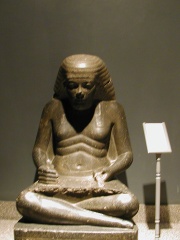
5. Amenhotep, son of Hapu (1420 BC - 1400 BC)
With an HPI of 66.24, Amenhotep, son of Hapu is the 5th most famous Egyptian Architect. His biography has been translated into 29 different languages.
Amenhotep, son of Hapu (transcribed jmn-ḥtp zꜣ ḥꜣp.w; fl. early-mid 14th century BC) was an ancient Egyptian architect, a priest, a herald, a scribe, and a public official, who held a number of offices under Amenhotep III of the 18th Dynasty. He was posthumously deified as a god of healing.

6. Hassan Fathy (1900 - 1989)
With an HPI of 64.09, Hassan Fathy is the 6th most famous Egyptian Architect. His biography has been translated into 25 different languages.
Hassan Fathy (Egyptian Arabic: حسن فتحي; March 23, 1900 – November 30, 1989) was a noted Egyptian architect who pioneered appropriate technology for building in Egypt, especially by working to reestablish the use of adobe and traditional mud construction as opposed to western building designs, material configurations, and lay-outs. Fathy was recognized with the Aga Khan Chairman's Award for Architecture in 1980.

7. Nefermaat (b. 2500 BC)
With an HPI of 62.87, Nefermaat is the 7th most famous Egyptian Architect. His biography has been translated into 23 different languages.
Nefermaat I (fl. c. 2570 BC) was an ancient Egyptian prince, a son of king Sneferu. He was a vizier possessing the titles of the king's eldest son, royal seal bearer, and prophet of Bastet. His name means "Maat is beautiful" or "With perfect justice".
People
Pantheon has 7 people classified as Egyptian architects born between 2800 BC and 1900. Of these 7, none of them are still alive today. The most famous deceased Egyptian architects include Khufu, Imhotep, and Senenmut.
Deceased Egyptian Architects
Go to all RankingsKhufu
2700 BC - 2570 BC
HPI: 86.57
Imhotep
2800 BC - 2700 BC
HPI: 81.17
Senenmut
1600 BC - 1463 BC
HPI: 68.57
Hemiunu
2500 BC - 2501 BC
HPI: 67.31
Amenhotep, son of Hapu
1420 BC - 1400 BC
HPI: 66.24
Hassan Fathy
1900 - 1989
HPI: 64.09
Nefermaat
2500 BC - Present
HPI: 62.87

